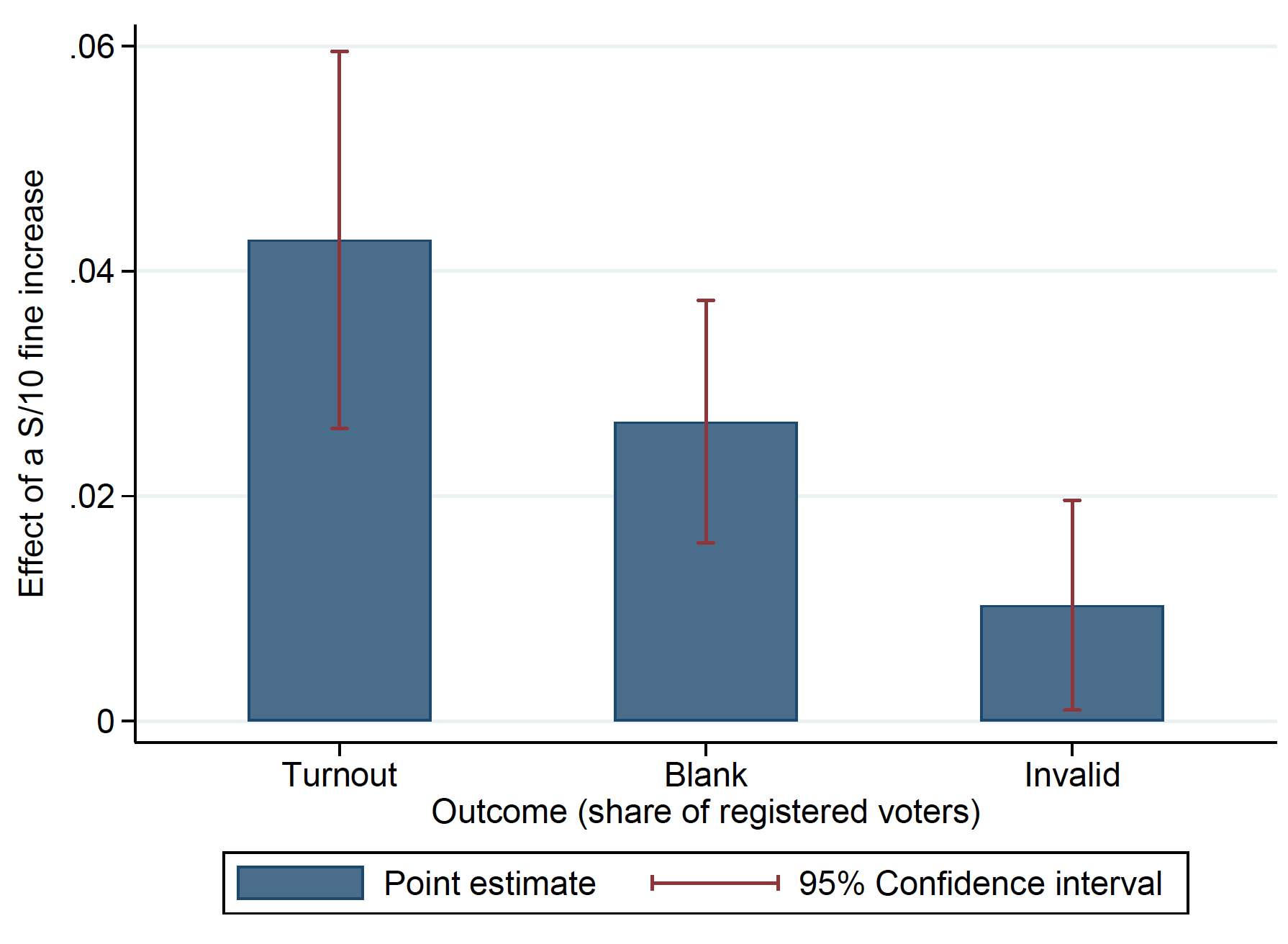
A larger fine for electoral abstention increases voter turnout but does not affect election outcomes in settings with compulsory voting
Compulsory voting can help to increase voter turnout.
Voting is the main tool that citizens in democracies can use to shape government policies and hold public officials to account (Ashworth 2012). Unfortunately, electoral participation remains low in many parts of the developing world. For example, less than 30% of voters turned out for the 2023 presidential election in Nigeria and slightly more than 50% in El Salvador in 2024.
Which policies are effective at increasing voter turnout? A large body of research has used field experiments to explore the effects of Get-Out-The-Vote campaigns (Gerber and Green 2017), but the extent to which we can extrapolate experimental findings like these to large-scale policies is uncertain (Niehaus 2019). One plausible policy alternative is the introduction of compulsory voting, which former US president Barack Obama has praised as potentially “transformative” (CNN 2015, The Guardian 2016). Currently, compulsory voting laws exist in almost 30 countries, and ten of them enforce the mandate to vote through a fine for electoral abstention (IDEA 2023).
Existing research shows that compulsory voting leads to higher turnout even with very low fines or enforcement (Funk 2007, Cepaluni and Hidalgo 2016, Hoffman et al. 2017). But voters’ responses to a change in the value of the fine remain uncertain: stronger monetary incentives to vote could crowd out voters’ intrinsic motivation, potentially even reducing electoral participation (Bénabou and Tirole 2003, 2006). The effects on electoral results are also unclear. The answer to these questions has important policy implications, given the potential trade-off between the increased effectiveness of a larger fine and its greater burden on those who are sanctioned.
What happens when the value of the fine for abstention changes?
In Gonzales et al. (2022), we study a nationwide reform to the value of the abstention fine in Peru, a middle-income country with more than 20 million voters and compulsory voting. Until 2006, the value of the abstention fine was homogeneous throughout the country. Following that year’s national elections, a newly introduced reform classified districts into three categories, based on their poverty level, and differentially reduced the value of the fine (Figure 1). Using administrative data covering four election cycles, we analyse voters’ short- and long-term responses along several margins, including turnout, registration, and invalid and blank votes.
Figure 1: The abstention fine by election and fine category

Figure 2 shows estimates from a difference-in-difference model with district and time fixed effects. The plot shows the difference in voter turnout in national elections among high- and low-fine districts, relative to medium-fine ones. Before the reform, this difference is quite stable. After the reform, we observe a systematic divergence in electoral participation between fine categories, leading to a 5 percentage point (pp) turnout gap between high- and low-fine districts by 2016, a sizable difference that could impact electoral outcomes.
Figure 2: The reform to the abstention fine and voter turnout

On average, we estimate that a 10 Peruvian Sol (S/) fine increase (roughly US$3) leads to a 0.5 pp increase in voter turnout. This estimate is substantially smaller than the one provided in León (2017) from a field experiment in the same setting, which involved an informational campaign about the modified value of the fine. This discrepancy is consistent with the large-scale government policy being much less effective than a salient experimental intervention. We conjecture that this `voltage drop’ arises because not all voters are informed about the change in regulation.
We also find that voters adapt to changes in regulation along unexpected margins. In Figure 3, we document a relative increase in the number of registered voters in low-fine districts after the reform. In Peru, all individuals over the age of 18 are automatically registered to vote, but their voting district depends on the address in their national ID (DNI.) Our results are consistent with voters intentionally manipulating their registered address to face a lower abstention fine. These effects on registration, which are not typically captured in short-lived, localised field experiments, could lead to large biases in representation.
Figure 3: The reform to the abstention fine and voter registration

Does the outcome of the election change?
Unfortunately, the volatility of Peruvian politics in recent decades inhibits us from studying party vote shares. However, we can study the effect of monetary incentives to vote on the share of blank or invalid votes. Figure 4 shows that a S/ 10 increase in the value of the fine leads on average to a 0.37 pp increase in the number of blank (0.27 pp) or invalid votes (0.1 pp) in the first round of the presidential election. This is equivalent to a staggering 86% of the observed effect of the fine on turnout. This finding indicates that incentivising electoral participation may have a very small impact on election outcomes, since most voters drawn to the polls by a larger fine end up casting a blank/invalid vote, perhaps because they are uninformed or uninterested.
Figure 4: The reform to the abstention fine and blank/invalid votes

How important is the fine?
Besides the monetary incentive provided by the fine, compulsory voting also provides non-monetary incentives, including the expressive function of the law as a signaling device for socially desirable behaviour (Funk 2007) and the temporary restrictions on government services faced by non-voters. To gauge the relative importance of the monetary incentive, we benchmark our estimates against the aggregate effect of compulsory voting on turnout. For this purpose, we exploit the exemption from the mandate to vote for citizens above the age of 69. Using granular data at the voting booth level from the 2016 elections, we compare turnout rates in booths with varying shares of barely-exempt (with ages slightly above 69) and almost-exempt (aged 69) voters.
Figure 5 shows that the senior citizen exemption from compulsory voting leads to a decrease in voter turnout of almost 10 pp at age 70 and 20 pp by age 72. Using data from neighboring Chile (which does not have compulsory voting), and running a similar analysis, we confirm that these effects are not driven by other factors, such as the worsening of health and mobility among the elderly. A back-of-the-envelope calculation using our previous results yields that a 100% fine reduction would lead to a decrease in turnout which is only 18% as large as the one caused by the exemption from compulsory voting between ages 69-72 (10% of the drop by age 75).
Figure 5: Senior exemption from compulsory voting and voter turnout

We conclude that monetary incentives have a robust, positive effect on electoral participation. However, there are three important caveats that policy-makers must keep in mind when contemplating the scale-up of experimental interventions in political economy. First, the bundle of incentives provided by mandatory voting is substantially more effective than even large changes to the value of the fine. Hence, compulsory voting with low fines helps reduce the burden on those who pay them without fundamentally undermining the effectiveness of the system. Secondly, in a setting where citizens do not face substantial barriers to electoral participation, the provision of powerful turnout incentives mainly affects disengaged citizens and has a negligible impact on electoral outcomes. Finally, large-scale implementation of policies to increase electoral participation must carefully consider imperfect knowledge about the policy incentives, as well as potential unintended consequences. People respond in a multidimensional and sophisticated way to changes in the regulatory environment and it is difficult to capture this rich response in localised and short-lived field experiments.
References
Ashworth, S (2012), "Electoral Accountability: Recent Theoretical and Empirical Work", Annual Review of Political Science, 15(1): 183-201.
Cepaluni, G and F D Hidalgo (2016), "Compulsory Voting Can Increase Political Inequality: Evidence from Brazil", Political Analysis, 24(2): 273-280.
CNN (2015), "Obama: Maybe it’s time for mandatory voting", March 19, 2015. https://www.cnn.com/2015/03/19/politics/obama-mandatory-voting/index.html
Funk, P (2007), "Is There An Expressive Function of Law? An Empirical Analysis of Voting Laws with Symbolic Fines", American Law and Economics Review, 9(1): 135-159.
Bénabou, R and J Tirole (2003), "Intrinsic and Extrinsic Motivation", Review of Economic Studies, 70(3): 489-520.
Bénabou, R and J Tirole (2006), "Incentives and Prosocial Behavior", American Economic Review, 96(5): 1652-1678.
Gerber, A S and D P Green (2017), "Field Experiments on Voter Mobilization: An Overview of a Burgeoning Literature", In A V Banerjee and E Duflo (Eds.), Handbook of Economic Field Experiments, Vol 1, North-Holland, pp. 395-438.
Gonzáles, M, G León, and L Martínez (2022), "How Effective Are Monetary Incentives to Vote? Evidence from a Nationwide Policy", American Economic Journal: Applied Economics, 14(1): 293-326.
Hoffman, M, G León, and M Lombardi (2017), "Compulsory Voting, Turnout, and Government Spending: Evidence from Austria", Journal of Public Economics, 145: 103–115.
IDEA (2023), "International Institute for Democracy and Electoral Assistance: Compulsory Voting", https://www.idea.int/data-tools/data/voter-turnout/compulsory-voting
León, G (2017), "Turnout, Political Preferences and Information: Experimental Evidence From Peru", Journal of Development Economics, 127: 56-71.
Niehaus, P (2019), "RCTs: Why scale matters", https://voxdev.org/topic/methods-measurement/rcts-why-scale-matters
The Guardian (2016), "Barack Obama praises Australia’s mandatory voting rules", April 09, 2016. https://www.theguardian.com/us-news/2016/apr/10/barack-obama-praises-australias-mandatory-voting-rules



